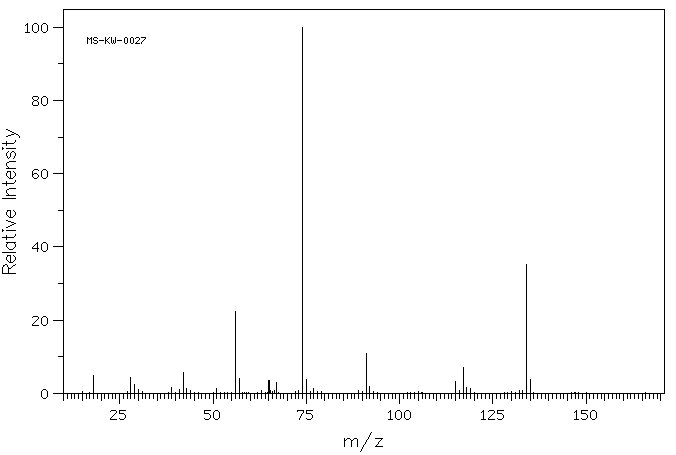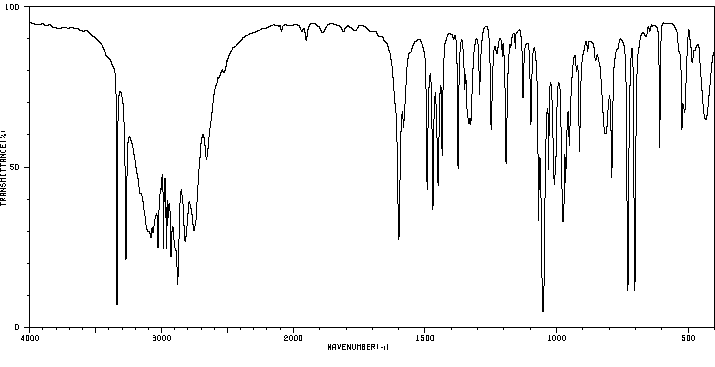2-amino-2-methyl-3-phenylpropan-1-ol | 21394-84-3
中文名称
——
中文别名
——
英文名称
2-amino-2-methyl-3-phenylpropan-1-ol
英文别名
2-amino-2-methyl-3-phenyl-1-propanol
CAS
21394-84-3
化学式
C10H15NO
mdl
——
分子量
165.235
InChiKey
HYRNHINXZCYRME-UHFFFAOYSA-N
BEILSTEIN
——
EINECS
——
-
物化性质
-
计算性质
-
ADMET
-
安全信息
-
SDS
-
制备方法与用途
-
上下游信息
-
文献信息
-
表征谱图
-
同类化合物
-
相关功能分类
-
相关结构分类
计算性质
-
辛醇/水分配系数(LogP):0.8
-
重原子数:12
-
可旋转键数:3
-
环数:1.0
-
sp3杂化的碳原子比例:0.4
-
拓扑面积:46.2
-
氢给体数:2
-
氢受体数:2
SDS
上下游信息
-
上游原料
中文名称 英文名称 CAS号 化学式 分子量 alpha-甲基-DL-苯丙氨酸 2-methyl-3-phenylalanine 1132-26-9 C10H13NO2 179.219 2-甲基-L-苯丙氨酸一水物 (S)-2-amino-2-methyl-3-phenylpropanoic acid 23239-35-2 C10H13NO2 179.219 2-氨基-3-(邻甲苯基)丙酸乙酯 α-methylphenylalanine ethyl ester 46438-07-7 C12H17NO2 207.272
反应信息
-
作为反应物:描述:2-amino-2-methyl-3-phenylpropan-1-ol 在 草酰氯 、 sodium cyanoborohydride 、 1-羟基苯并三唑 、 二甲基亚砜 、 N,N'-二环己基碳二亚胺 作用下, 以 四氢呋喃 、 二氯甲烷 、 异丙醇 为溶剂, 反应 2.75h, 生成 Nα-[N-(4-phenylbutyryl)-L-propyl-DL-2-amino-2-methyl-3-phenylpropyl]-L-arginine参考文献:名称:Tri- and tetrapeptide analogs of kinins as potential renal vasodilators摘要:Tri- and tetrapeptide analogues were synthesized and evaluated as renal vasodilators. These peptides were prepared by standard coupling reactions, which also provided good yields with hindered alpha-methyl amino acid derivatives. Preliminary evidence of renal vasodilator activity was determined in anesthetized dogs by measuring the effects on renal blood flow and calculating the accompanying changes in renal vascular resistance. The most potent compounds contained, in their basic structure, the L-prolyl-DL-alpha-methylphenylalanyl-L-arginine and L-prolyl-DL-alpha-methylphenylalanylglycyl-L-proline arrays. Substitution on the N-terminal proline with 4-phenylbutyryl and 4-(4-hydroxyphenyl)butyryl side chains produced enhanced renal vasodilator activity and, in certain cases, selectivity for the renal vasculature.DOI:10.1021/jm00369a017
-
作为产物:描述:alpha-甲基-DL-苯丙氨酸 在 sodium tetrahydroborate 、 碘 作用下, 以 四氢呋喃 为溶剂, 反应 20.0h, 生成 2-amino-2-methyl-3-phenylpropan-1-ol参考文献:名称:自由和 N-苄氧羰基保护的 2,2-二取代牛磺酸的多功能合成摘要:开发了一种有效且通用的方法来合成 N-苄氧羰基保护的游离 2,2-二取代牛磺酸。获得了几种新的 2,2-二取代牛磺酸,包括脂肪族/芳香族和环状/无环衍生物,这证明了该方法的通用性。(© Wiley-VCH Verlag GmbH & Co. KGaA, 69451 Weinheim, Germany, 2008)DOI:10.1002/ejoc.200700791
文献信息
-
Ligand‐Controlled Regiodivergence in Nickel‐Catalyzed Hydroarylation and Hydroalkenylation of Alkenyl Carboxylic Acids**作者:Zi‐Qi Li、Yue Fu、Ruohan Deng、Van T. Tran、Yang Gao、Peng Liu、Keary M. EngleDOI:10.1002/anie.202010840日期:2020.12.14the ligand environment around the metal center dictates the regiochemical outcome. Markovnikov hydrofunctionalization products are obtained under mild ligand‐free conditions, with up to 99 % yield and >20:1 selectivity. Alternatively, anti‐Markovnikov products can be accessed with a novel 4,4‐disubstituted Pyrox ligand in excellent yield and >20:1 selectivity. Both electronic and steric effects on the
-
[EN] BENZOLACTAM COMPOUNDS AS PROTEIN KINASE INHIBITORS<br/>[FR] COMPOSÉS BENZOLACTAMES UTILISÉS EN TANT QU'INHIBITEURS DE PROTÉINE KINASE申请人:OTSUKA PHARMA CO LTD公开号:WO2017068412A1公开(公告)日:2017-04-27The invention provides a compound of formula (0): or a pharmaceutically acceptable salt, N-oxide or tautomer thereof. The compounds are inhibitors of ERK 1/2 kinases and will be useful in the treatment of ERKl/2-mediated conditions. The compounds are therefore useful in therapy, in particular in the treatment of cancer.
-
[EN] BENZYLETHER AND BENZYLAMINO BETA-SECRETASE INHIBITORS FOR THE TREATMENT OF ALZHEIMER'S DISEASE<br/>[FR] INHIBITEURS DE BENZYLETHER ET BENZYLAMINO DE BETA-SECRETASE POUR TRAITER LA MALADIE D'ALZHEIMER申请人:MERCK & CO INC公开号:WO2005051914A1公开(公告)日:2005-06-09The present invention is directed to benzylether and benzylamino derivative compounds which are inhibitors of the beta-secretase enzyme and that are useful in the treatment of diseases in which the beta-secretase enzyme is involved, such as Alzheimer's disease. The invention is also directed to pharmaceutical compositions comprising these compounds and the use of these compounds and compositions in the treatment of such diseases in which the beta-secretase enzyme is involved.
-
Rapid and Selective Synthesis of Substituted 1,2,5-Thiadiazolidine 1,1-Dioxides作者:Andrew Madin、Joanne Hannam、Timothy Harrison、Felicity Heath、Kevin MerchantDOI:10.1055/s-2006-939039日期:——The reaction of N,N-dimethylsulfamoyl aziridines with primary amines gives direct access to substituted 1,2,5-thiadiazolidines in a regioselective manner. Furthermore, the product from reaction with 4-methoxybenzyl amine can be subsequently manipulated to give the alternative nitrogen substitution pattern in a controlled fashion.
-
On the Origin of Asymmetric Induction of the Palladium-Catalyzed Allylic Substitution Reaction with Chiral 4,4-Disubstituted 4,5-Dihydro-2-(phosphinoaryl)oxazole Ligands作者:Silvia Schaffner、Jürgen F. K. Müller、Markus Neuburger、Margareta ZehnderDOI:10.1002/hlca.19980810533日期:——4-monosubstituted 4,5-dihydro-2-(phosphinoaryl)oxazole ligand 1a reveals important structural differences (Fig. 3). 1H-NMR Spectroscopic investigation confirm that the 4,4-disubstituted 4,5-dihydro-2-(phosphinoaryl)oxazole ligand 4 of 5 and 6 shows the same conformation in solution as in the solid state (Table 2). The application of ligand (S)-4 in the Pd-catalyzed allylic substitution demonstrates a的X射线分析(η 3 -烯丙基)4-苄基-2- [2-(二苯基膦基κP)苯基] -4,5-二氢- 4-4-甲基恶唑κ Ñ }合钯(II)六氟磷酸盐(5)与类似的[将Pd(η 3 -1,3- diphenylallyl)]络合物6呈现。与(ηA比较3 -烯丙基) -和(η-1,3- diphenylallyl)钯络合物2和3分别含有,4-单取代的4,5-二氢-2-(phosphinoaryl)恶唑配体1a中揭示了重要结构差异(图3)。1个H-NMR光谱学研究证实,4,4-二取代4,5-二氢-2-(phosphinoaryl)恶唑配体4的5只6示出了在溶液中的相同的构象在固体状态(表2)。配体(S)-4在Pd催化的烯丙基取代中的应用表明,中间体(参见络合物6)中烯丙基配体的取向与烯丙基取代产物的绝对构型之间存在构型关系(表3) 。
表征谱图
-
氢谱1HNMR
-
质谱MS
-
碳谱13CNMR
-
红外IR
-
拉曼Raman
-
峰位数据
-
峰位匹配
-
表征信息
同类化合物
(βS)-β-氨基-4-(4-羟基苯氧基)-3,5-二碘苯甲丙醇
(S,S)-邻甲苯基-DIPAMP
(S)-(-)-7'-〔4(S)-(苄基)恶唑-2-基]-7-二(3,5-二-叔丁基苯基)膦基-2,2',3,3'-四氢-1,1-螺二氢茚
(S)-盐酸沙丁胺醇
(S)-3-(叔丁基)-4-(2,6-二甲氧基苯基)-2,3-二氢苯并[d][1,3]氧磷杂环戊二烯
(S)-2,2'-双[双(3,5-三氟甲基苯基)膦基]-4,4',6,6'-四甲氧基联苯
(S)-1-[3,5-双(三氟甲基)苯基]-3-[1-(二甲基氨基)-3-甲基丁烷-2-基]硫脲
(R)富马酸托特罗定
(R)-(-)-盐酸尼古地平
(R)-(-)-4,12-双(二苯基膦基)[2.2]对环芳烷(1,5环辛二烯)铑(I)四氟硼酸盐
(R)-(+)-7-双(3,5-二叔丁基苯基)膦基7''-[((6-甲基吡啶-2-基甲基)氨基]-2,2'',3,3''-四氢-1,1''-螺双茚满
(R)-(+)-7-双(3,5-二叔丁基苯基)膦基7''-[(4-叔丁基吡啶-2-基甲基)氨基]-2,2'',3,3''-四氢-1,1''-螺双茚满
(R)-(+)-7-双(3,5-二叔丁基苯基)膦基7''-[(3-甲基吡啶-2-基甲基)氨基]-2,2'',3,3''-四氢-1,1''-螺双茚满
(R)-(+)-4,7-双(3,5-二-叔丁基苯基)膦基-7“-[(吡啶-2-基甲基)氨基]-2,2”,3,3'-四氢1,1'-螺二茚满
(R)-3-(叔丁基)-4-(2,6-二苯氧基苯基)-2,3-二氢苯并[d][1,3]氧杂磷杂环戊烯
(R)-2-[((二苯基膦基)甲基]吡咯烷
(R)-1-[3,5-双(三氟甲基)苯基]-3-[1-(二甲基氨基)-3-甲基丁烷-2-基]硫脲
(N-(4-甲氧基苯基)-N-甲基-3-(1-哌啶基)丙-2-烯酰胺)
(5-溴-2-羟基苯基)-4-氯苯甲酮
(5-溴-2-氯苯基)(4-羟基苯基)甲酮
(5-氧代-3-苯基-2,5-二氢-1,2,3,4-oxatriazol-3-鎓)
(4S,5R)-4-甲基-5-苯基-1,2,3-氧代噻唑烷-2,2-二氧化物-3-羧酸叔丁酯
(4S,4''S)-2,2''-亚环戊基双[4,5-二氢-4-(苯甲基)恶唑]
(4-溴苯基)-[2-氟-4-[6-[甲基(丙-2-烯基)氨基]己氧基]苯基]甲酮
(4-丁氧基苯甲基)三苯基溴化磷
(3aR,8aR)-(-)-4,4,8,8-四(3,5-二甲基苯基)四氢-2,2-二甲基-6-苯基-1,3-二氧戊环[4,5-e]二恶唑磷
(3aR,6aS)-5-氧代六氢环戊基[c]吡咯-2(1H)-羧酸酯
(2Z)-3-[[(4-氯苯基)氨基]-2-氰基丙烯酸乙酯
(2S,3S,5S)-5-(叔丁氧基甲酰氨基)-2-(N-5-噻唑基-甲氧羰基)氨基-1,6-二苯基-3-羟基己烷
(2S,2''S,3S,3''S)-3,3''-二叔丁基-4,4''-双(2,6-二甲氧基苯基)-2,2'',3,3''-四氢-2,2''-联苯并[d][1,3]氧杂磷杂戊环
(2S)-(-)-2-{[[[[3,5-双(氟代甲基)苯基]氨基]硫代甲基]氨基}-N-(二苯基甲基)-N,3,3-三甲基丁酰胺
(2S)-2-[[[[[((1S,2S)-2-氨基环己基]氨基]硫代甲基]氨基]-N-(二苯甲基)-N,3,3-三甲基丁酰胺
(2S)-2-[[[[[[((1R,2R)-2-氨基环己基]氨基]硫代甲基]氨基]-N-(二苯甲基)-N,3,3-三甲基丁酰胺
(2-硝基苯基)磷酸三酰胺
(2,6-二氯苯基)乙酰氯
(2,3-二甲氧基-5-甲基苯基)硼酸
(1S,2S,3S,5S)-5-叠氮基-3-(苯基甲氧基)-2-[(苯基甲氧基)甲基]环戊醇
(1S,2S,3R,5R)-2-(苄氧基)甲基-6-氧杂双环[3.1.0]己-3-醇
(1-(4-氟苯基)环丙基)甲胺盐酸盐
(1-(3-溴苯基)环丁基)甲胺盐酸盐
(1-(2-氯苯基)环丁基)甲胺盐酸盐
(1-(2-氟苯基)环丙基)甲胺盐酸盐
(1-(2,6-二氟苯基)环丙基)甲胺盐酸盐
(-)-去甲基西布曲明
龙蒿油
龙胆酸钠
龙胆酸叔丁酯
龙胆酸
龙胆紫-d6
龙胆紫








